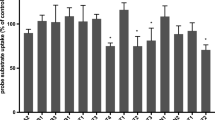Abstract
Background
Susceptibility to cisplatin (CDDP) nephrotoxicity is known to vary between individuals, but the basis of this variation has not been fully elucidated. In the kidney, CDDP is taken up into the renal proximal tubular cells mainly via SLC22A2 organic cation transporter 2 (OCT2) and secreted into lumen via other transporters including SLC47A1 multidrug and toxin extrusion 1 (MATE1). Here, we explore the effect of single-nucleotide polymorphisms (SNPs) at 808G>T in OCT2 and at rs2289669 G>A in MATE1 on CDDP-induced adverse events.
Methods
Fifty-three patients who had been treated with CDDP were enrolled. The plasma concentration of CDDP was measured on days 4 and 7 after treatment. The grade of hematology and nephrotoxicity was evaluated by Common Terminology Criteria for Adverse Events.
Results
In the first treatment cycle, serum creatinine (SCr) levels in the patients with OCT2 808GG and 808GT were increased by 1.43- and 1.19-fold, respectively. In the total treatment cycles, 12 patients (27 %) with 808GG experienced over grade 2 SCr elevation, whereas those with 808GT did not show any apparent nephrotoxicity. The hematological toxicity and plasma concentrations of CDDP showed no difference between patients in both groups. The rs2289669 G>A SNP in MATE1 was not associated with adverse effects and disposition of CDDP.
Conclusion
The 808G>T SNP in OCT2 ameliorated CDDP-induced nephrotoxicity without alteration of disposition, whereas the rs2289669 G>A SNP in MATE1 had no effect on CDDP toxicity.



Similar content being viewed by others
References
Schrier RW. Cancer therapy and renal injury. J Clin Invest. 2002;110:743–5.
Deng J, Kohda Y, Chiao H, Wang Y, Hu X, Hewitt SM, et al. Interleukin-10 inhibits ischemic and cisplatin-induced acute renal injury. Kidney Int. 2001;60:2118–28.
Ramesh G, Reeves WB. TNF-alpha mediates chemokine and cytokine expression and renal injury in cisplatin nephrotoxicity. J Clin Invest. 2002;110:835–42.
Lieberthal W, Triaca V, Levine J. Mechanisms of death induced by cisplatin in proximal tubular epithelial cells: apoptosis vs. necrosis. Am J Physiol. 1996;270:F700–8.
Pritchard JB, Miller DS. Renal secretion of organic anions and cations. Kidney Int. 1996;49:1649–54.
Inui K, Masuda S, Saito H. Cellular and molecular aspects of drug transport in the kidney. Kidney Int. 2000;58:944–58.
Okuda M, Saito H, Urakami Y, Takano M, Inui K. cDNA cloning and functional expression of a novel rat kidney organic cation transporter, OCT2. Biochem Biophys Res Commun. 1996;224:500–7.
Ohta KY, Inoue K, Hayashi Y, Yuasa H. Molecular identification and functional characterization of rat multidrug and toxin extrusion type transporter 1 as an organic cation/H+ antiporter in the kidney. Drug Metab Dispos. 2006;34:1868–74.
Terada T, Masuda S, Asaka J, Tsuda M, Katsura T, Inui K. Molecular cloning, functional characterization and tissue distribution of rat H+/organic cation antiporter MATE1. Pharm Res. 2006;23:1696–701.
Otsuka M, Matsumoto T, Morimoto R, Arioka S, Omote H, Moriyama Y. A human transporter protein that mediates the final excretion step for toxic organic cations. Proc Natl Acad Sci USA. 2005;102:17923–8.
Filipski KK, Mathijssen RH, Mikkelsen TS, Schinkel AH, Sparreboom A. Contribution of organic cation transporter 2 (OCT2) to cisplatin-induced nephrotoxicity. Clin Pharmacol Ther. 2009;86:396–402.
Filipski KK, Loos WJ, Verweij J, Sparreboom A. Interaction of cisplatin with the human organic cation transporter 2. Clin Cancer Res. 2008;14:3875–80.
Ha Choi J, Wah Yee S, Kim MJ, Nguyen L, Ho Lee J, Kang JO, et al. Identification and characterization of novel polymorphisms in the basal promoter of the human transporter, MATE1. Pharmacogenet Genomics. 2009;19:770–80.
Chen Y, Teranishi K, Li S, Yee SW, Hesselson S, Stryke D, et al. Genetic variants in multidrug and toxic compound extrusion-1, hMATE1, alter transport function. Pharmacogenomics J. 2009;9:127–36.
Becker ML, Visser LE, van Schaik RH, Hofman A, Uitterlinden AG, Stricker BH. Genetic variation in the multidrug and toxin extrusion 1 transporter protein influences the glucose-lowering effect of metformin in patients with diabetes: a preliminary study. Diabetes. 2009;58:745–9.
Yokoo K, Murakami R, Matsuzaki T, Yoshitome K, Hamada A, Saito H. Enhanced renal accumulation of cisplatin via renal organic cation transporter deteriorates acute kidney injury in hypomagnesemic rats. Clin Exp Nephrol. 2009;13:578–84.
Matsuo S, Imai E, Horio M, Yasuda Y, Tomita K, Nitta K, et al. Revised equations for estimated GFR from serum creatinine in Japan. Am J Kidney Dis. 2009;53:982–92.
Song IS, Shin HJ, Shim EJ, Jung IS, Kim WY, Shon JH, et al. Genetic variants of the organic cation transporter 2 influence the disposition of metformin. Clin Pharmacol Ther. 2008;84:559–62.
Wang ZJ, Yin OQ, Tomlinson B, Chow MS. OCT2 polymorphisms and in vivo renal functional consequence: studies with metformin and cimetidine. Pharmacogenet Genomics. 2008;18:637–45.
Hutchison FN, Perez EA, Gandara DR, Lawrence HJ, Kaysen GA. Renal salt wasting in patients treated with cisplatin. Ann Intern Med. 1988;108:21–5.
Cornelison TL, Reed E. Nephrotoxicity and hydration management for cisplatin, carboplatin, and ormaplatin. Gynecol Oncol. 1993;50:147–58.
Meyer KB, Madias NE. Cisplatin nephrotoxicity. Miner Electrolyte Metab. 1994;20:201–13.
Kim YK, Byun HS, Kim YH, Woo JS, Lee SH. Effect of cisplatin on renal function in rabbits: mechanism of reduced glucose reabsorption. Toxicol Appl Pharmacol. 1995;130:19–26.
Nowak G. Protein kinase C-alpha and ERK1/2 mediate mitochondrial dysfunction, decreases in active Na+ transport, and cisplatin-induced apoptosis in renal cells. J Biol Chem. 2002;277:43377–8823.
Yonezawa A, Masuda S, Yokoo S, Katsura T, Inui K. Cisplatin and oxaliplatin, but not carboplatin and nedaplatin, are substrates for human organic cation transporters (SLC22A1-3 and multidrug and toxin extrusion family). J Pharmacol Exp Ther. 2006;319:879–86.
Acknowledgments
This work was supported in part by a Grant-in-Aid for Scientific Research from Japan Society for the Promotion of Science (JSPS) for Hideyuki Saito (KAKENHI 21390048).
Conflict of interest
All the authors have declared no competing interest.
Author information
Authors and Affiliations
Corresponding author
About this article
Cite this article
Iwata, K., Aizawa, K., Kamitsu, S. et al. Effects of genetic variants in SLC22A2 organic cation transporter 2 and SLC47A1 multidrug and toxin extrusion 1 transporter on cisplatin-induced adverse events. Clin Exp Nephrol 16, 843–851 (2012). https://doi.org/10.1007/s10157-012-0638-y
Received:
Accepted:
Published:
Issue Date:
DOI: https://doi.org/10.1007/s10157-012-0638-y




